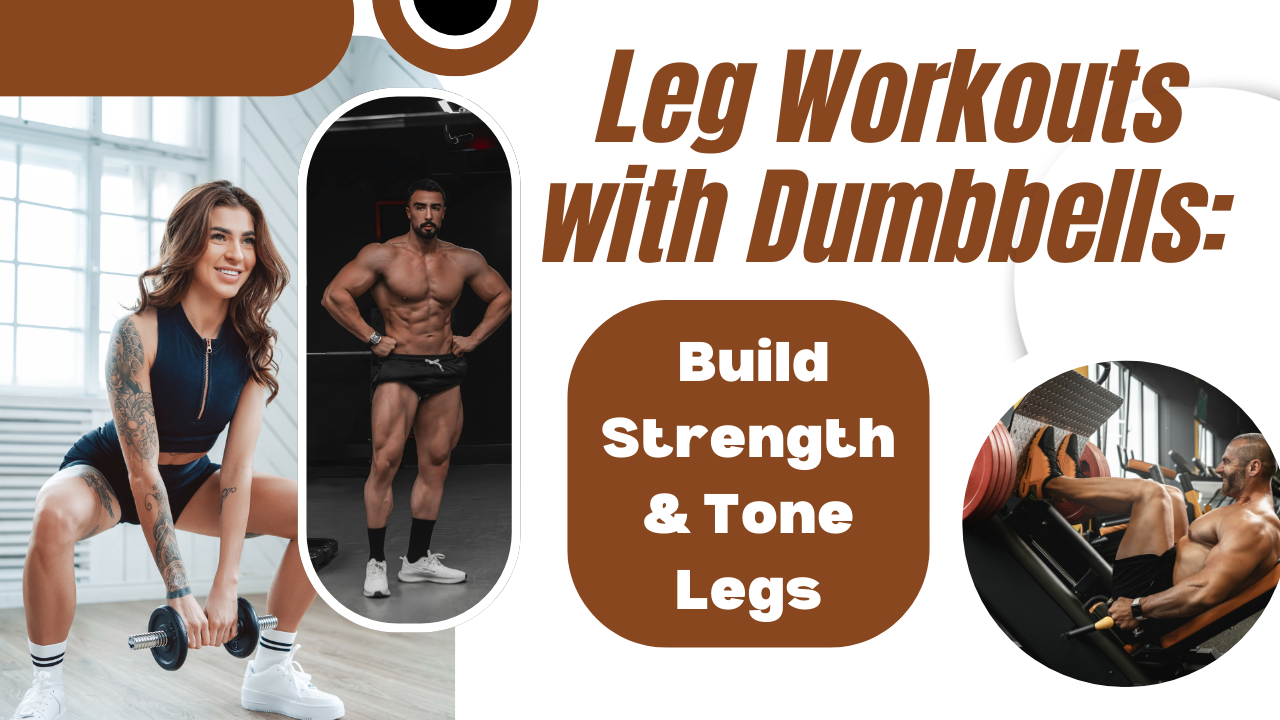Leg Workouts with Dumbbells are an excellent way to build lower body strength without relying on bulky gym machines. They provide versatile resistance, allow full range of motion, and can be easily adjusted to match your fitness level. Whether training at home or in a gym, dumbbells make effective leg training accessible for everyone.
Leg workouts with dumbbells target major muscles like quads, hamstrings, glutes, and calves while also engaging stabilizing muscles that improve balance and coordination. Exercises such as goblet squats, lunges, Romanian deadlifts, and step-ups can help enhance strength, endurance, and muscle definition efficiently.
This comprehensive guide on leg workouts with dumbbells includes benefits, key exercises, and the top 8 tips to maximize results. Following these strategies ensures a challenging, safe, and results-driven lower-body routine, perfect for home or gym
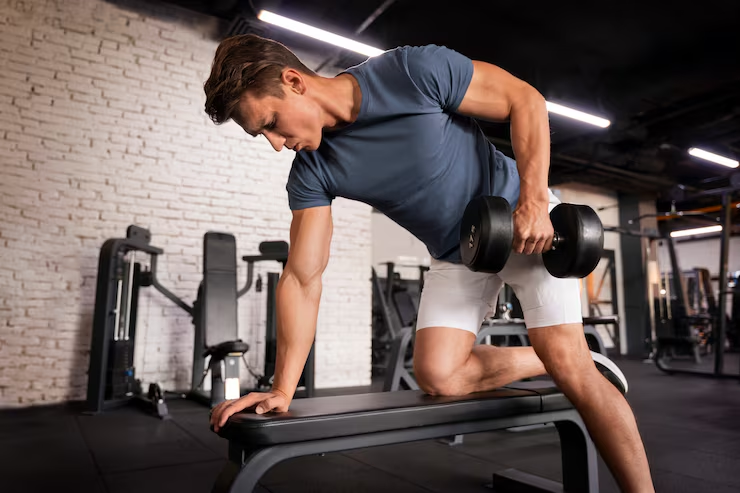
🏋️ Why Choose Dumbbells for Leg Workouts ?
Dumbbells offer unmatched versatility for leg workouts with dumbbells, allowing you to perform a wide range of exercises without the need for bulky machines. From goblet squats to lunges and Romanian deadlifts, dumbbells target all major lower-body muscles, including quads, hamstrings, glutes, and calves, while also engaging stabilizing muscles for balance and coordination.
Leg workouts with dumbbells provide the advantage of unilateral training, meaning each leg works independently. This helps correct strength imbalances, improve symmetry, and enhance overall functional performance. Unlike barbells, dumbbells allow a natural range of motion, reducing strain on joints and lowering the risk of injury while maintaining effective resistance.
Another key benefit of leg workouts with dumbbells is convenience. They can be used at home, in a gym, or while traveling, making them accessible to almost anyone. Incorporating dumbbells ensures a challenging, efficient, and safe lower-body routine for strength, endurance, and muscle growth.
Before diving into the exercises and routines, let’s break down why dumbbells are an excellent choice for leg training:
Accessibility and Convenience: You don’t need a gym membership or bulky equipment. A pair of adjustable or fixed dumbbells is all it takes to target every major muscle group in your legs.
Functional Strength: Unlike machines, dumbbell workouts engage stabilizing muscles, which means better balance and real-world strength.
Improved Balance and Coordination: Using dumbbells forces each side of your body to work independently. This helps eliminate muscle imbalances and improves coordination.
Range of Motion and Flexibility: Dumbbells allow a more natural movement pattern and greater range of motion, which is crucial for joint health and muscle development.
Scalability: From beginners to advanced lifters, dumbbells come in various weights, so you can scale up as you progress.
How Does Leg Workouts with Dumbbells Work ?
Leg workouts with dumbbells work by providing resistance that challenges your lower-body muscles, stimulating strength and growth. When performing exercises like goblet squats, lunges, or Romanian deadlifts, the dumbbells force your quads, hamstrings, glutes, and calves to engage fully. The added weight increases muscle activation compared to bodyweight exercises alone, making workouts more effective.
These workouts also improve stability and coordination. Since each leg works independently when using dumbbells, your core and stabilizing muscles are activated to maintain balance. This unilateral approach helps correct muscle imbalances, enhance functional strength, and promote better overall movement patterns, which are critical for athletic performance and everyday activities.
Leg workouts with dumbbells are highly adaptable. By adjusting the weight, reps, sets, or tempo, you can tailor sessions for strength, hypertrophy, endurance, or fat loss. Consistently challenging your muscles through progressive overload ensures long-term gains, improved lower-body performance, and balanced muscular development.
When to Do Leg Workouts with Dumbbells
Timing your leg workouts with dumbbells depends on your fitness goals, schedule, and recovery needs. For strength and hypertrophy, performing these exercises 2–3 times per week with at least 48 hours of rest between sessions allows your muscles to repair and grow. Avoid training legs on consecutive days to prevent overtraining and reduce the risk of injury.
Morning or evening sessions both work effectively, depending on personal preference. Some people feel more energized and perform better in the morning, while others may lift heavier in the evening after proper meals and warm-up. The key is consistency—choosing a time that fits your routine ensures you stick with leg workouts with dumbbells long-term.
Leg workouts with dumbbells can also be incorporated after upper-body sessions or as part of a full-body split. Structuring your program with proper frequency and rest ensures maximum strength gains, muscle growth, and improved lower-body performance.
💪 Major Leg Muscles Targeted by Dumbbell Workouts
To train your legs effectively, it’s essential to understand the muscles you’re working. Dumbbell leg workouts can target all these areas:
Quadriceps (Front of the thigh)
Hamstrings (Back of the thigh)
Glutes (Buttocks)
Calves (Lower legs)
Adductors and Abductors (Inner and outer thighs)
🔥 Top Tips for Effective Leg Workouts with Dumbbells
Now let’s get into the real value — how to make the most out of your leg workouts using dumbbells.
Focus on Compound Movements First
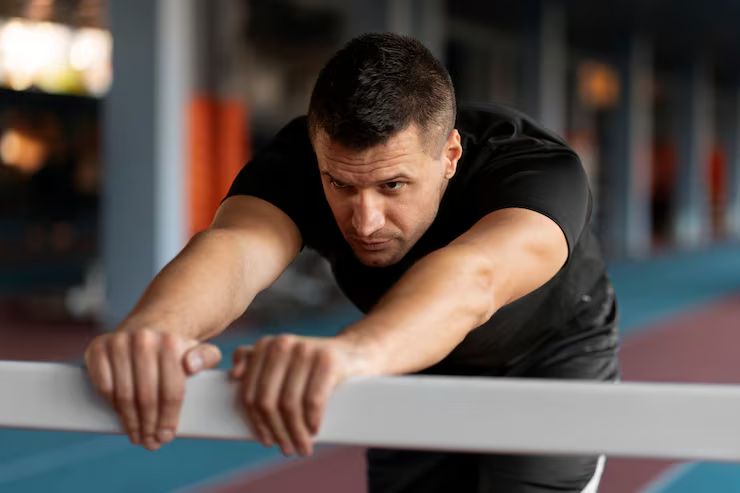
Compound exercises are a cornerstone of effective leg workouts with dumbbells because they engage multiple joints and muscle groups simultaneously. Moves like dumbbell squats, lunges, and Romanian deadlifts target the quads, hamstrings, glutes, and calves while also activating the core for stability. This makes them highly efficient, allowing you to get a full lower-body workout in less time.
Incorporating compound exercises into leg workouts with dumbbells helps improve overall strength and functional fitness. Since these exercises mimic real-life movements, they enhance balance, coordination, and mobility, which can translate to better performance in sports and daily activities. Additionally, using multiple muscles at once increases calorie burn, making compound movements ideal for both strength building and fat loss.
For best results, leg workouts with dumbbells should prioritize proper form and progressive overload. By gradually increasing weight or reps, you challenge your muscles, prevent plateaus, and stimulate growth. Combining compound exercises with accessory movements ensures a balanced, effective lower-body routine that builds power, endurance, and muscle definition.
Best Compound Dumbbell Leg Exercises:
Dumbbell Squats
Dumbbell Lunges
Dumbbell Romanian Deadlifts
Dumbbell Step-Ups
Tip: Always start your workout with compound moves to recruit the most muscle mass and boost metabolism.
Prioritize Form Over Weight
Proper form is crucial in leg workouts with dumbbells to maximize results and minimize the risk of injury. Lifting heavy weights with incorrect technique can strain muscles, ligaments, and joints, potentially causing long-term damage. Even small mistakes in posture or alignment can compromise effectiveness and lead to discomfort or injury over time.
Maintaining correct form ensures that the targeted muscles, such as quads, hamstrings, glutes, and calves, are fully engaged during each exercise. In leg workouts with dumbbells, this means performing squats, lunges, and deadlifts with controlled movements, keeping your core engaged, and avoiding excessive forward lean or knee collapse. Proper form not only protects the body but also optimizes muscle activation for faster strength gains and improved endurance.
To master leg workouts with dumbbells safely, start with lighter weights until your technique is solid. Focus on slow, controlled movements and gradually increase resistance. Pairing proper form with progressive overload ensures effective, injury-free workouts and long-term lower-body development.
Form Tips:
Keep your back straight and core engaged.
Knees should not cave inward.
Go through a full range of motion — no half-reps.
Don’t rush the reps; control the movement.
Tip: Master the movement with lighter weights before increasing resistance.
Use Progressive Overload

Progressive overload is essential in leg workouts with dumbbells to continue building strength and muscle. By gradually increasing the resistance, volume, or intensity of your exercises, you challenge your muscles to adapt and grow. Without this consistent progression, gains can plateau, and workouts may become less effective over time.
In leg workouts with dumbbells, progressive overload can be applied in multiple ways. You can increase the weight of the dumbbells, add more repetitions or sets, or reduce rest periods between exercises. For example, performing goblet squats with slightly heavier dumbbells each week or adding an extra set of lunges ensures your muscles are continuously stimulated, promoting growth and endurance.
Consistency and careful planning are key to successful progressive overload. Tracking your performance, maintaining proper form, and gradually increasing the challenge in leg workouts with dumbbells ensures long-term strength development, improved muscle tone, and enhanced lower-body performance.
Ways to apply progressive overload:
Increase dumbbell weight.
Add more reps or sets.
Slow down the tempo.
Reduce rest between sets.
Add challenging variations (e.g., Bulgarian split squats).
Tip: Keep a workout journal to track progress.
Mix Unilateral and Bilateral Exercises
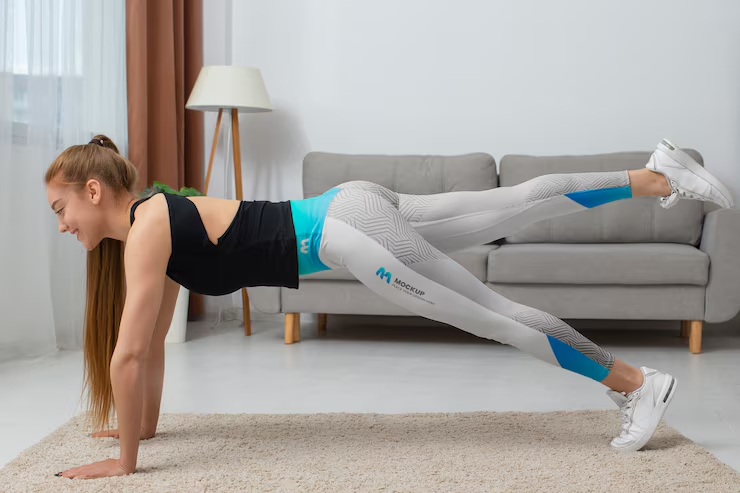
Many people unknowingly have one leg stronger than the other, which can create imbalances and affect overall performance. Incorporating unilateral exercises into leg workouts with dumbbells helps address this issue by targeting each leg individually. Exercises such as Bulgarian split squats, single-leg deadlifts, and step-ups ensure both legs are equally challenged.
Unilateral leg workouts with dumbbells improve stability and coordination by forcing the body to engage core muscles and stabilizers to maintain balance. This not only enhances lower-body strength but also reduces the risk of injuries caused by uneven muscle development. Focusing on one leg at a time allows you to correct weaknesses and promote symmetry in muscle growth.
For maximum benefits, include unilateral exercises consistently in your leg workouts with dumbbells routine. Start with lighter weights to master form, then progressively increase resistance. Over time, this approach builds balanced strength, improves functional performance, and enhances overall athleticism.
Try These:
Dumbbell Bulgarian Split Squats
Dumbbell Step-Ups
Dumbbell Single-Leg Deadlifts
Tip: Always perform single-leg exercises on both sides, starting with your weaker leg.
Activate Glutes Before Heavy Lifting: Strong glutes are essential for overall leg development, athletic performance, and lower back health. But many people have inactive or underperforming glutes.
Pre-Workout Glute Activation:
Bodyweight hip thrusts
Glute bridges (with or without dumbbells)
Banded lateral walks
Tip: Do 1-2 glute activation exercises before starting your main sets.
Incorporate Tempo Training
Tempo plays a crucial role in leg workouts with dumbbells because it determines the speed at which each phase of a movement is performed. By controlling the pace of lifts, you can increase time under tension, which directly stimulates muscle growth and improves strength. Slowing down both the lowering and lifting phases ensures that the targeted muscles are fully engaged throughout the exercise.
Incorporating tempo training in leg workouts with dumbbells also enhances form and control. For example, performing a goblet squat with a slow descent and controlled ascent forces the quads, hamstrings, and glutes to work harder while reducing the risk of injury. This deliberate pace improves mind-muscle connection, helping you maximize the effectiveness of each repetition.
To implement tempo in leg workouts with dumbbells, start with lighter weights to maintain proper control. Experiment with different tempos—such as 3 seconds down, 1 second pause, 2 seconds up—to challenge your muscles, increase endurance, and promote consistent strength and size gains.
Example:
Squat down for 3 seconds
Hold for 1 second at the bottom
Rise in 1 second
Pause for 1 second at the top
Tip: Use a 3-1-1-1 tempo to burn out muscles without needing super-heavy dumbbells.
Don’t Skip Calf Training
Calves are often neglected, but they play a key role in balance, walking, and overall leg aesthetics.
Dumbbell Calf Exercises:
Standing Dumbbell Calf Raises
Seated Dumbbell Calf Raises
Single-Leg Calf Raises
Tip: Perform high reps (15–25) for calves as they are slow-twitch dominant muscles.
Include Mobility and Stretching
Strong legs are vital, but without proper mobility, even well-developed muscles can lead to stiffness and increased risk of injury. Incorporating stretching into leg workouts with dumbbells ensures that muscles and joints maintain flexibility, allowing you to perform exercises with proper form and full range of motion. Flexible muscles also enhance overall performance, making each workout more effective.
Stretching after leg workouts with dumbbells helps reduce muscle soreness by promoting blood flow and aiding recovery. Dynamic stretches before your workout warm up the muscles, while static stretches afterward relieve tension built up during exercises like squats, lunges, and deadlifts. This approach not only prevents discomfort but also supports long-term joint health.
Additionally, mobility work improves balance and coordination, which are critical for maintaining stability during leg workouts with dumbbells. By consistently incorporating stretching and mobility exercises, you can prevent injuries, enhance performance, and ensure sustainable lower-body strength and growth over time.
Essential Leg Stretches:
Hamstring stretch
Quad stretch
Calf stretch
Hip flexor stretch
Tip: Spend 5–10 minutes post-workout doing static stretching and foam rolling.
🧱 Sample Dumbbell Leg Workout Routine
Here’s a complete dumbbell leg workout you can do at home or in the gym:
Warm-Up (5–10 Minutes)
Jumping jacks (1 min)
Bodyweight squats (15 reps)
Glute bridges (15 reps)
Walking lunges (10 each leg)
Main Workout:
Exercise Sets Reps
Dumbbell Goblet Squats 4 10–12
Dumbbell Romanian Deadlifts 3 10
Dumbbell Bulgarian Split Squats 3 8 each leg
Dumbbell Walking Lunges 2 10 each leg
Dumbbell Calf Raises 3 15–20
Cool-Down:
Static stretches for quads, hamstrings, calves, and hips
Foam rolling (optional)
🧠 Mind-Muscle Connection: Why It Matters
The mind-muscle connection refers to the conscious and intentional focus on the muscle you’re working during an exercise. This improves muscle engagement and contraction.
How to Improve It:
Visualize the muscle working.
Avoid distractions during sets.
Squeeze the target muscle at the top of the rep.
Tip: Slow down your reps and eliminate momentum to truly feel the burn.
📅 Weekly Dumbbell Leg Workout Plan (2 Days/Week)
| Day | Exercise | Sets x Reps |
|---|---|---|
| Day 1 – Strength Focus | Dumbbell Goblet Squats | 4 x 8 |
| Dumbbell Deadlifts | 4 x 8 | |
| Bulgarian Split Squats | 3 x 8 each leg | |
| Standing Calf Raises | 3 x 20 | |
| Day 2 – Hypertrophy & Endurance | Dumbbell Walking Lunges | 3 x 12 each leg |
| Dumbbell Step-Ups | 3 x 10 each leg | |
| Dumbbell Glute Bridges | 3 x 15 | |
| Seated Dumbbell Calf Raises | 3 x 25 |
✅ Conclusion
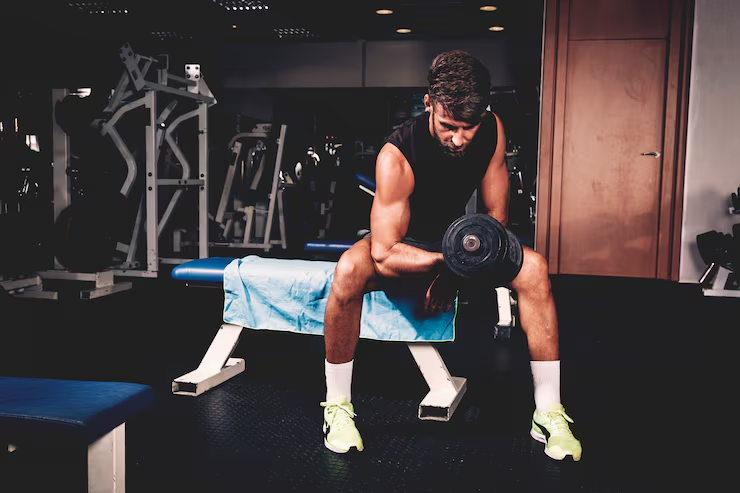
Dumbbells might seem simple, but don’t underestimate their power. With the right techniques, you can sculpt powerful, toned, and functional legs using only this one tool. The key is consistency, proper form, progressive overload, and a focus on mind-muscle connection.
Whether you’re training at home or looking to switch things up in your gym routine, leg workouts with dumbbells offer a flexible, effective, and scalable approach to lower body strength and development.
FAQs
Q1. Can you build big legs with dumbbells only ?
Yes, you can build strong and muscular legs using just dumbbells — especially if you apply progressive overload, train consistently, and follow a structured workout plan. Exercises like dumbbell squats, lunges, and Romanian deadlifts can be just as effective as barbell movements when performed correctly.
Q2. How heavy should my dumbbells be for leg workouts ?
Your dumbbell weight should be challenging but manageable. For strength, choose a weight where you can do 6–8 reps with good form. For muscle growth (hypertrophy), aim for 10–15 reps. If you’re doing higher reps for endurance, go lighter but maintain control and form.
Q3. How many times per week should I train legs with dumbbells ?
For most people, 1–2 times per week is ideal for leg training. This allows enough recovery while giving you enough volume to see progress. Make sure to incorporate rest days and avoid overtraining.
Q4. What if I only have light dumbbells ? Will they still work ?
Absolutely! If your dumbbells are light, increase the reps, slow down the tempo, and add isometric holds or pulse reps to increase intensity. You can also reduce rest time between sets to keep the workout challenging.
Q5. Do I need to warm up before a dumbbell leg workout ?
Yes, warming up is essential. It prepares your muscles and joints, improves performance, and reduces injury risk. A good warm-up includes light cardio (e.g., jumping jacks), dynamic stretches, and activation drills like glute bridges or bodyweight squats.

